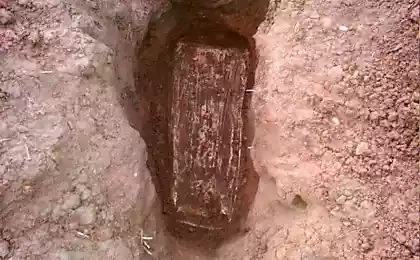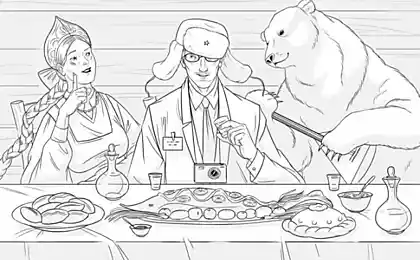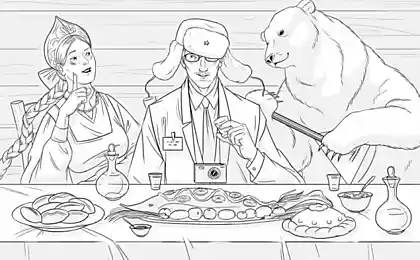670
Archaeologists have discovered in Egypt the remains of the victims of the epidemic
Italian archeologists have found in Egypt the remains of the victims of the epidemic, which was so terrible that an ancient writer considered it a harbinger of the end of the world.
Italian archaeological expedition found in Egypt, human remains, covered with a thick layer of lime (used as disinfectant). The researchers also discovered three kilns did lime, and traces of a huge fire, which burned the victims of the pestilence.
Four million nine hundred thirty thousand fifty nine
Evidence of the epidemic uncovered in the burial complex of Harvy and Hajimeru (Harwa and Akhimenru), who was in the area of ancient Thebes (modern Luxor), on the West Bank of the Nile.
Fragments of pottery found in the kilns allowed Dating them to the III century ad, a time when a series of epidemics now known as the "plague of Cyprian" ravaged the Roman Empire (Egypt at that time was part of the Empire). St. Cyprian was Bishop of Carthage, who saw in the epidemic, the signs of the end of the world.
Pestilence, raged about 250-271 ad, was very ambitious. According to some, in just one day from the epidemic died on 5 thousand inhabitants of Rome, writes Francesco Tiradritti, leader of the expedition, in the latest issue of the journal "Egyptian archaeology".
Expedition Francesco Tiradritti studied evidence of plague in the period between 1997 and 2012. The monument, which is explored by the archaeologists, was built in the VII century BC to the Grand steward named Harv. After his death, the Egyptians continuously used the monument for burial. However, once there they buried the victims of pestilence, the monument was abandoned and never used.
Eighty six million ninety seven thousand nine hundred ninety one
The use of the "for the destruction of infected corpses gave the monument a bad reputation and doomed it to centuries of oblivion until grave robbers did not enter the complex in the early nineteenth century," notes Francesco Tiradritti.
Cyprian of Carthage left a terrible description of what happened to the victims of the pestilence until their death: "...relaxation of the stomach robs us of physical strength, ... heat from the inside, jumping in laryngeal ulcers, irritate them, ... continuous vomiting shakes inside, a rush of blood makes the inflammation in the eyes, ... some cut off hands and other members as a result of contagious rot, ... from relaxing the body is trembling in the legs, nagrazhdaetsja hearing…»
Cyprian believed that the plague is a harbinger of the end of the world:
"So, vozlyublennaya brothers, with pure thoughts, strong faith and constant doblesti will be better prepared to fulfill the will of God; removing from yourself the fear of death, let us ponder the following for her immortality... So you should always do the servants of God; how much more must do so now, when it is destroyed the world is covered in storms, hostile angry".
"But the world fluctuates and falls, indicating his destruction not so much the decay, how much approaching his demise…»
Of course, the "plague of Cyprian" was not the end of the world, but it severely weakened the Roman Empire. The epidemic killed two Roman emperors: Hostilian – in the year 251 and Claudius II Gothicus in 270-m. it is Widely believed that the "plague of Cyprian" accelerated the decline of the Roman Empire.
Remains open in Luxor, indirectly confirm the scale of the epidemic. Italian archaeologists have found no evidence that over the dead was performed any religious rites. "They [the Egyptians] had to get rid of them [bodies], not wasting time," says Francesco Tiradritti.
According to modern researchers the pestilence was probably one of the types of smallpox or measles.
Newly-discovered remains will give anthropologists new material to study, but to extract their DNA will not succeed, said the archaeologist. Although reports of researchers on DNA extracted from mummies (for example, Tutanhamona), occupied the front pages of the media, Francesco Tiradritti does not believe in the results of the analysis of such ancient samples. "In such a climate, as in Egypt, the DNA is completely destroyed," – said the head of the Italian expedition. The best conditions for preserving DNA is permafrost, says the researcher.
The opening of the burial of victims of the plague – only one direction of work of the Italian mission in Egypt. Thebes is a huge monument with a vast necropolis, and the excavations of Italian archaeologists provide information about how the area had changed since the VII century BC to the present day.
The funerary complex of Harvy and Chimero, large "private" funerary monument of Egypt has been under study since 1995. He is considered one of the key monuments for the study of the art of Egypt the period of the "Saite Renaissance" is the last independent flowering of Egyptian civilization. This period lasted from early VII century until the mid-sixth century BC.
Based on: Live Science
Source: nkj.ru
Italian archaeological expedition found in Egypt, human remains, covered with a thick layer of lime (used as disinfectant). The researchers also discovered three kilns did lime, and traces of a huge fire, which burned the victims of the pestilence.
Four million nine hundred thirty thousand fifty nine
Evidence of the epidemic uncovered in the burial complex of Harvy and Hajimeru (Harwa and Akhimenru), who was in the area of ancient Thebes (modern Luxor), on the West Bank of the Nile.
Fragments of pottery found in the kilns allowed Dating them to the III century ad, a time when a series of epidemics now known as the "plague of Cyprian" ravaged the Roman Empire (Egypt at that time was part of the Empire). St. Cyprian was Bishop of Carthage, who saw in the epidemic, the signs of the end of the world.
Pestilence, raged about 250-271 ad, was very ambitious. According to some, in just one day from the epidemic died on 5 thousand inhabitants of Rome, writes Francesco Tiradritti, leader of the expedition, in the latest issue of the journal "Egyptian archaeology".
Expedition Francesco Tiradritti studied evidence of plague in the period between 1997 and 2012. The monument, which is explored by the archaeologists, was built in the VII century BC to the Grand steward named Harv. After his death, the Egyptians continuously used the monument for burial. However, once there they buried the victims of pestilence, the monument was abandoned and never used.
Eighty six million ninety seven thousand nine hundred ninety one
The use of the "for the destruction of infected corpses gave the monument a bad reputation and doomed it to centuries of oblivion until grave robbers did not enter the complex in the early nineteenth century," notes Francesco Tiradritti.
Cyprian of Carthage left a terrible description of what happened to the victims of the pestilence until their death: "...relaxation of the stomach robs us of physical strength, ... heat from the inside, jumping in laryngeal ulcers, irritate them, ... continuous vomiting shakes inside, a rush of blood makes the inflammation in the eyes, ... some cut off hands and other members as a result of contagious rot, ... from relaxing the body is trembling in the legs, nagrazhdaetsja hearing…»
Cyprian believed that the plague is a harbinger of the end of the world:
"So, vozlyublennaya brothers, with pure thoughts, strong faith and constant doblesti will be better prepared to fulfill the will of God; removing from yourself the fear of death, let us ponder the following for her immortality... So you should always do the servants of God; how much more must do so now, when it is destroyed the world is covered in storms, hostile angry".
"But the world fluctuates and falls, indicating his destruction not so much the decay, how much approaching his demise…»
Of course, the "plague of Cyprian" was not the end of the world, but it severely weakened the Roman Empire. The epidemic killed two Roman emperors: Hostilian – in the year 251 and Claudius II Gothicus in 270-m. it is Widely believed that the "plague of Cyprian" accelerated the decline of the Roman Empire.
Remains open in Luxor, indirectly confirm the scale of the epidemic. Italian archaeologists have found no evidence that over the dead was performed any religious rites. "They [the Egyptians] had to get rid of them [bodies], not wasting time," says Francesco Tiradritti.
According to modern researchers the pestilence was probably one of the types of smallpox or measles.
Newly-discovered remains will give anthropologists new material to study, but to extract their DNA will not succeed, said the archaeologist. Although reports of researchers on DNA extracted from mummies (for example, Tutanhamona), occupied the front pages of the media, Francesco Tiradritti does not believe in the results of the analysis of such ancient samples. "In such a climate, as in Egypt, the DNA is completely destroyed," – said the head of the Italian expedition. The best conditions for preserving DNA is permafrost, says the researcher.
The opening of the burial of victims of the plague – only one direction of work of the Italian mission in Egypt. Thebes is a huge monument with a vast necropolis, and the excavations of Italian archaeologists provide information about how the area had changed since the VII century BC to the present day.
The funerary complex of Harvy and Chimero, large "private" funerary monument of Egypt has been under study since 1995. He is considered one of the key monuments for the study of the art of Egypt the period of the "Saite Renaissance" is the last independent flowering of Egyptian civilization. This period lasted from early VII century until the mid-sixth century BC.
Based on: Live Science
Source: nkj.ru























